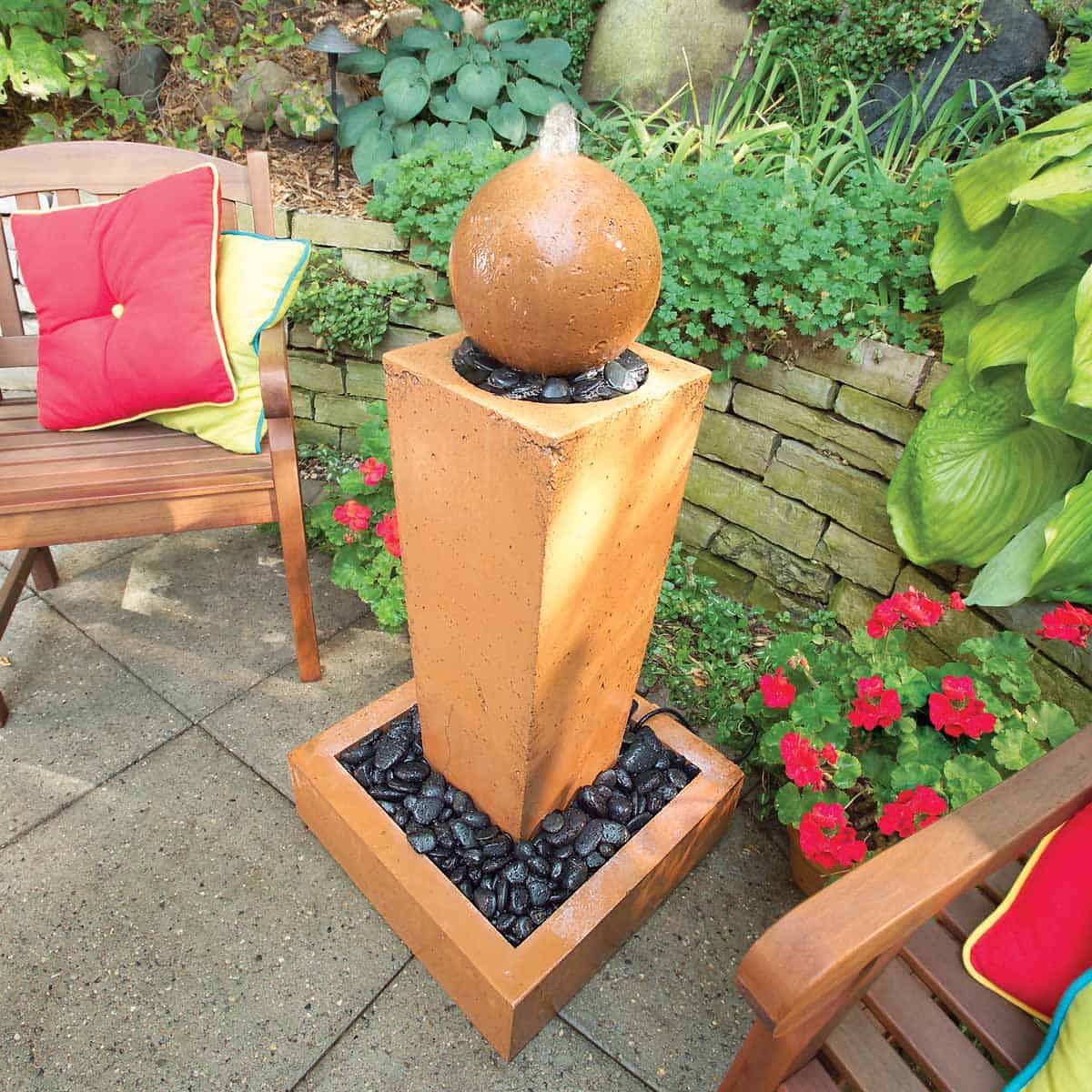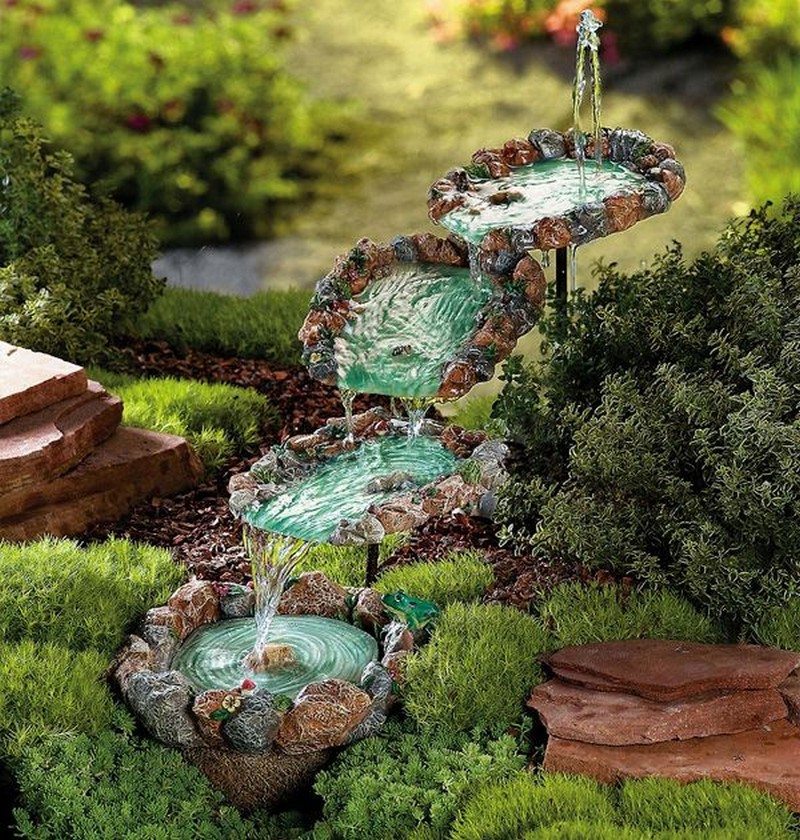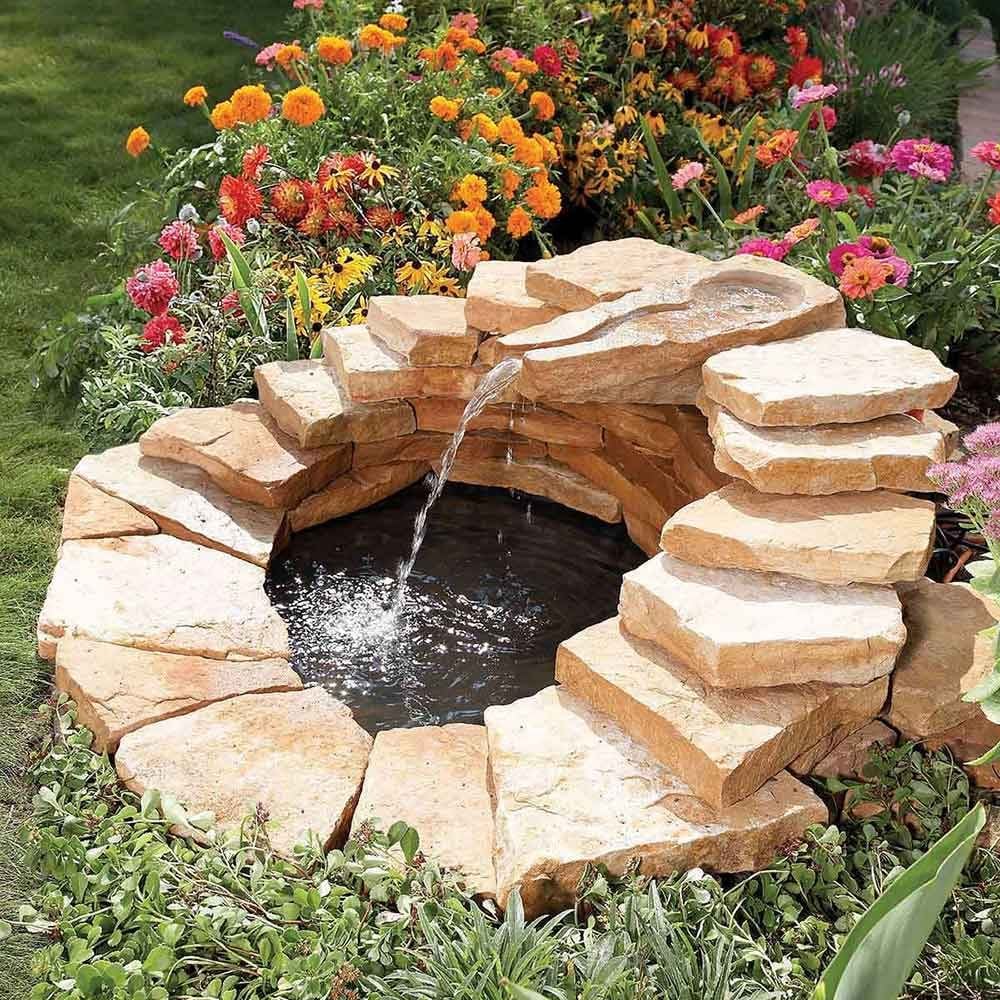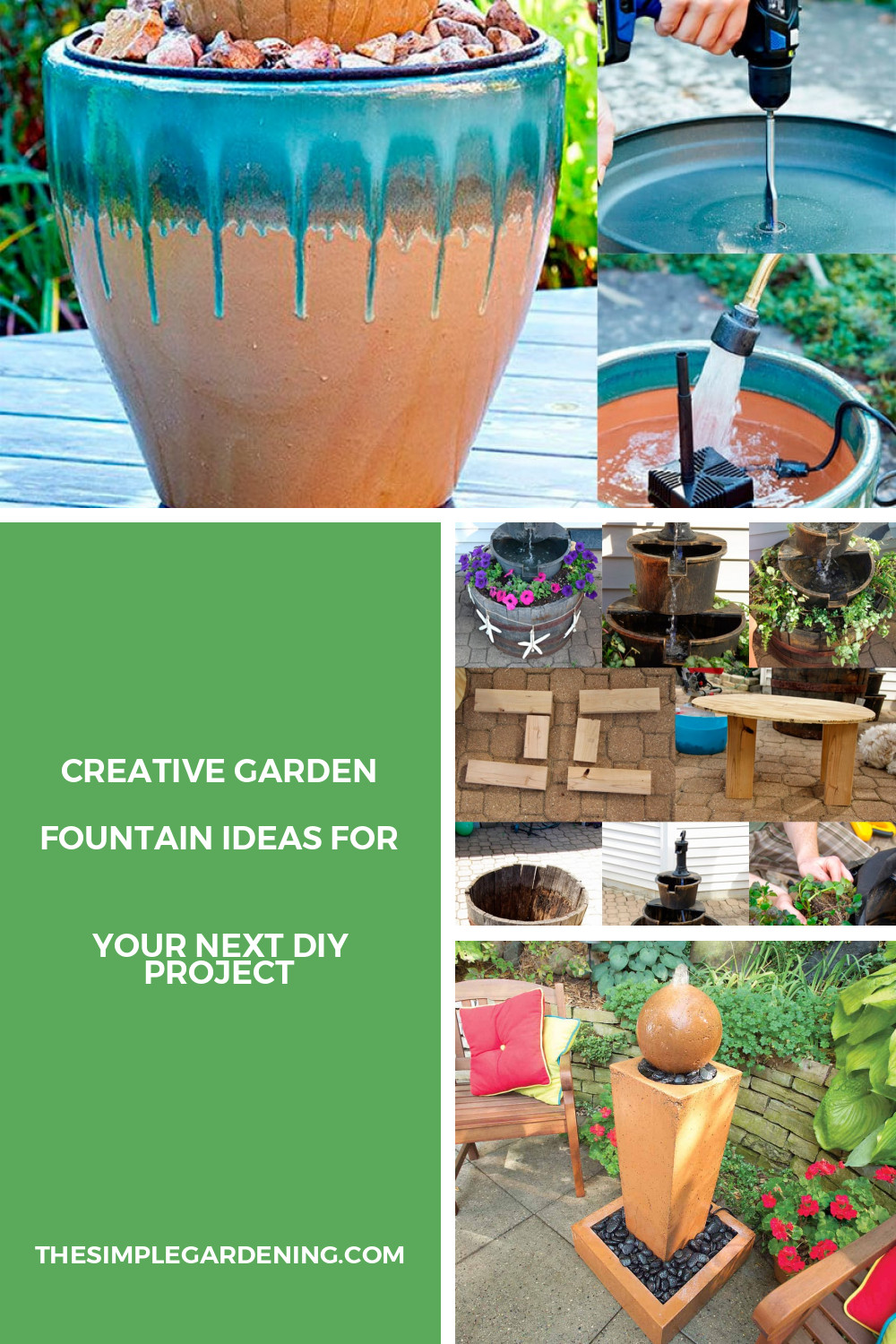Transforming your garden into a tranquil oasis with a DIY garden fountain can be an incredibly rewarding project. Not only does it add a visual focal point, but the soothing sounds of flowing water can create a peaceful atmosphere. In this article, we’ll delve into everything you need to know to create your own garden fountain, from planning and materials to design and maintenance. Let’s dive in!
Benefits of Having a Garden Fountain
Adding a garden fountain brings a multitude of benefits that enhance your outdoor living space.
Health and Well-being
A garden fountain can improve your mental health and well-being by providing a serene environment. The sound of flowing water has been shown to reduce stress and anxiety.
| Benefit | Explanation |
|---|---|
| Stress Reduction | The soothing sound of water can lower cortisol levels and promote relaxation. |
| Enhanced Mood | Natural elements and water features can elevate mood and increase feelings of happiness. |
| Improved Air Quality | Water fountains can help to humidify the air, making it easier to breathe, especially in dry areas. |
| Natural White Noise | The constant flow of water acts as white noise, which can help in masking unwanted sounds. |
| Increased Focus | A tranquil environment with a garden fountain can boost concentration and productivity. |
Aesthetic and Functional Benefits
Garden fountains also offer a range of aesthetic and functional advantages.
| Benefit | Explanation |
|---|---|
| Visual Appeal | Fountains serve as a beautiful focal point in any garden. |
| Wildlife Attraction | Birds, butterflies, and other wildlife are attracted to water sources, enhancing your garden’s ecosystem. |
| Property Value | Adding a well-designed fountain can increase the value of your property. |
| Cooling Effect | The evaporation of water from the fountain can help cool the surrounding air. |
| Humidity Control | Fountains can help maintain humidity levels, which is beneficial for plant health. |

Source Image: freshpatio.com
Different Styles of Garden Fountains
Choosing the right style for your garden fountain is crucial to match the overall theme of your garden. Here are some popular styles to consider:
Classic Stone Fountains
These fountains offer a timeless appeal and can be the centerpiece of a traditional garden.
| Feature | Description |
|---|---|
| Material | Typically made from natural stone or cast stone. |
| Design | Includes ornate designs with classical motifs such as cherubs, urns, and intricate carvings. |
| Maintenance | Requires regular cleaning to prevent algae and moss growth. |
| Cost | Generally higher due to the materials and craftsmanship involved. |
| Ideal Setting | Perfect for formal gardens with symmetrical layouts and traditional plantings. |
Modern Minimalist Designs
Modern fountains emphasize clean lines and simplicity, often incorporating sleek materials like metal and glass.
| Feature | Description |
|---|---|
| Material | Commonly use stainless steel, glass, or polished stone. |
| Design | Features minimalist shapes like spheres, rectangles, and smooth curves. |
| Maintenance | Easier to clean due to fewer intricate details. |
| Cost | Can range from affordable to high-end depending on materials and size. |
| Ideal Setting | Suits contemporary gardens with geometric designs and minimalist landscaping. |
Rustic and Natural Look
These fountains blend seamlessly into natural or woodland gardens, often using organic shapes and materials.
| Feature | Description |
|---|---|
| Material | Uses natural materials like wood, stone, and repurposed items. |
| Design | Mimics natural water features such as streams or waterfalls. |
| Maintenance | Requires natural cleaning methods to maintain the rustic look. |
| Cost | Typically lower as they can incorporate found or recycled materials. |
| Ideal Setting | Best for gardens with a natural, wild, or cottage garden aesthetic. |
Materials and Tools You’ll Need
Before starting your DIY garden fountain, gather all necessary materials and tools to ensure a smooth construction process.
Essential Materials
| Material | Purpose |
|---|---|
| Fountain Pump | Circulates the water through the fountain. |
| Water Basin | Holds the water; can be a preformed liner or a waterproof container. |
| Tubing | Connects the pump to the water feature to direct water flow. |
| Decorative Stones | Used for aesthetic purposes and to hide the pump and tubing. |
| Sealant | Ensures all connections are watertight to prevent leaks. |
| Electrical Cords | Provides power to the pump; ensure it’s rated for outdoor use. |
Handy Tools
| Tool | Purpose |
|---|---|
| Shovel | For digging the hole for the basin or foundation. |
| Level | Ensures the fountain is installed evenly. |
| Pliers | Useful for adjusting tubing and securing connections. |
| Utility Knife | For cutting tubing to the required length. |
| Bucket | Helps in transporting water and materials. |

Source Image: freshpatio.com
Planning Your Garden Fountain
Proper planning is key to a successful garden fountain project. This stage involves several critical steps.
Choosing the Perfect Location
Selecting the right spot for your garden fountain is essential for both aesthetics and functionality.
| Consideration | Description |
|---|---|
| Visibility | Place the fountain where it can be easily seen and enjoyed. |
| Sunlight | Ensure the location receives enough sunlight, especially if using solar-powered features. |
| Accessibility | Make sure the fountain is accessible for maintenance and cleaning. |
| Surrounding Plants | Consider the impact of water spray on nearby plants; some plants thrive in moist conditions. |
| Power Source | Ensure proximity to a power source if your pump isn’t solar-powered. |
Deciding on the Fountain Style
Choosing the right style is crucial for aesthetic harmony.
| Style | Suitable Garden Type |
|---|---|
| Classic Stone | Formal, traditional gardens. |
| Modern Minimalist | Contemporary, urban gardens. |
| Rustic and Natural | Cottage, woodland, or naturalistic gardens. |
Calculating Budget and Time
Understanding the costs and time involved will help you stay on track.
| Factor | Consideration |
|---|---|
| Material Costs | Estimate costs for pump, basin, tubing, decorative elements, and tools. |
| Time Investment | Plan for several weekends if you’re building from scratch. |
| Additional Expenses | Consider costs for electricity, water usage, and potential repairs. |

Source Image: www.desertdomicile.com
Design Inspiration
Now, let’s explore some design inspirations to get your creative juices flowing.
Classic Stone Fountains
These fountains bring an old-world charm to your garden.
| Inspiration | Description |
|---|---|
| Tiered Fountain | Features multiple tiers, each with water cascading down. |
| Wall Fountain | Mounted on a garden wall, perfect for small spaces. |
| Birdbath Fountain | Combines a birdbath with a water fountain, attracting wildlife. |
Modern Minimalist Designs
Sleek and elegant, these designs are perfect for contemporary gardens.
| Inspiration | Description |
|---|---|
| Stainless Steel Sphere | Water cascades over a polished steel sphere, creating a reflective surface. |
| Zen Fountain | Incorporates smooth stones and bamboo for a calming effect. |
| Geometric Shapes | Uses clean lines and simple shapes like cubes or rectangles. |
Rustic and Natural Look
Blend your fountain seamlessly with nature.
| Inspiration | Description |
|---|---|
| Log Fountain | Uses hollowed-out logs for a natural water flow. |
| Stone Stack Fountain | Features stacked stones with water trickling down. |
| Recycled Materials | Incorporates repurposed items like old pots or barrels. |
Building Your Own Fountain Base
The base is the foundation of your garden fountain, so it’s important to get it right.
Using Concrete for a Solid Base
Concrete bases provide stability and durability.
| Step | Description |
|---|---|
| Mix Concrete | Follow the instructions on the concrete mix bag. |
| Pour into Mold | Use a wooden or plastic mold to shape the base. |
| Level the Surface | Ensure the concrete is level before it sets. |
| Let it Cure | Allow the concrete to cure for at least 24 hours. |
| Remove Mold | Carefully remove the mold once the concrete is set. |
Wooden Bases for a Rustic Appeal
Wooden bases offer a charming, rustic look but require proper treatment to withstand water exposure.
| Step | Description |
|---|---|
| Select Wood | Use rot-resistant wood like cedar or redwood. |
| Cut to Size | Measure and cut the wood to your desired dimensions. |
| Assemble Base | Use screws and wood glue to assemble the base. |
| Seal the Wood | Apply a waterproof sealant to protect the wood from moisture. |
| Install Basin | Place a waterproof liner or basin on top of the wooden base. |
Recycled Materials for an Eco-Friendly Option
Using recycled materials is both sustainable and cost-effective.
| Material | Description |
|---|---|
| Old Tires | Stack and seal old tires to create a unique base. |
| Broken Pots | Arrange broken pottery in an artistic manner. |
| Metal Barrels | Repurpose old barrels by lining them with a waterproof material. |

Source Image: www.pinterest.com
DIY Garden Fountains
Creating the Water Feature
The heart of your fountain is the water feature, where creativity meets functionality.
Pump Selection and Installation
Choosing the right pump ensures smooth water circulation.
| Step | Description |
|---|---|
| Select Pump | Choose a pump based on the fountain size and desired water flow rate. |
| Connect Tubing | Attach tubing to the pump outlet securely. |
| Submerge Pump | Place the pump in the water basin. |
| Power the Pump | Connect to a power source or solar panel. |
| Test Water Flow | Adjust the tubing and pump settings for desired water flow. |
Designing Water Flow Patterns
Different patterns can create varying visual and auditory effects.
| Pattern | Description |
|---|---|
| Cascade | Water flows down a series of steps or tiers. |
| Bubbling | Water bubbles up from a central point, ideal for small fountains. |
| Waterfall | A single stream falls into a lower basin. |
Ensuring Proper Water Circulation
Good circulation prevents stagnation and keeps the water fresh.
| Step | Description |
|---|---|
| Check Pump Power | Ensure the pump is powerful enough for the size of your fountain. |
| Regular Cleaning | Clean the pump and tubing regularly to prevent blockages. |
| Adjust Flow Rate | Modify the pump settings to optimize water movement. |

Source Image: theownerbuildernetwork.co
Incorporating Lighting
Adding lighting to your fountain enhances its beauty, especially at night.
Solar-Powered Lighting Options
Eco-friendly and easy to install, solar lights are a great choice.
| Feature | Description |
|---|---|
| Solar Panels | Place panels in a sunny spot to charge during the day. |
| LED Bulbs | Use energy-efficient LED bulbs for long-lasting illumination. |
| Placement | Position lights to highlight key features of the fountain. |
| Maintenance | Clean solar panels regularly for optimal performance. |
LED Lights for a Magical Evening Effect
LED lights can create stunning visual effects.
| Feature | Description |
|---|---|
| Color Options | Choose from a range of colors to suit your mood. |
| Waterproof | Ensure lights are waterproof for safe outdoor use. |
| Remote Control | Use a remote to easily change colors and settings. |
Tips for Safe Electrical Installation
Safety is paramount when working with electrical components in a garden setting.
| Tip | Description |
|---|---|
| Use GFCI Outlets | Install Ground Fault Circuit Interrupter outlets to prevent electrical shocks. |
| Waterproof Casing | Ensure all electrical connections are in waterproof casings. |
| Proper Grounding | Ground all electrical components to prevent short circuits. |
Decorative Elements
Enhance your fountain with various decorative elements to personalize your design.
Adding Plants and Greenery
Plants can soften the look of your fountain and blend it with the garden.
| Plant Type | Description |
|---|---|
| Aquatic Plants | Plants like water lilies and lotus add beauty and help oxygenate the water. |
| Marginal Plants | Grow around the edges of the fountain, such as cattails and irises. |
| Ferns | Add lush greenery and thrive in the moist environment. |
Using Stones and Pebbles for a Natural Look
Stones and pebbles can create a seamless transition between the fountain and the garden.
| Type | Description |
|---|---|
| River Rocks | Smooth and rounded, ideal for lining the basin. |
| Slate | Flat stones perfect for creating ledges and steps. |
| Gravel | Small pebbles that can cover the basin and hide the pump. |
Integrating Garden Statues and Ornaments
Add character to your fountain with statues and ornaments.
| Ornament Type | Description |
|---|---|
| Animal Statues | Frogs, birds, and other animals add a whimsical touch. |
| Fairy Figurines | Create a magical fairy garden theme. |
| Antique Ornaments | Repurposed antiques can add a unique charm. |

Source Image: www.familyhandyman.com
Sound and Water Flow
Achieving the perfect sound and water flow is crucial for creating a serene environment.
Achieving the Perfect Sound
The sound of water can range from a gentle trickle to a robust cascade.
| Sound Type | Description |
|---|---|
| Gentle Trickling | Ideal for a calm and relaxing atmosphere. |
| Bubbling | Provides a soft, gurgling sound. |
| Cascading | Creates a louder, more dynamic sound. |
Adjusting Water Flow for Tranquility
Fine-tuning the water flow can enhance the soothing effects of your fountain.
| Adjustment | Description |
|---|---|
| Flow Rate | Use the pump settings to increase or decrease water flow. |
| Placement | Position rocks or other elements to alter the flow path. |
| Multiple Streams | Create several small streams for a more varied sound. |
Soundproofing Techniques
Minimize unwanted noise and focus on the calming sound of water.
| Technique | Description |
|---|---|
| Soft Materials | Use soft materials like moss or foam to dampen mechanical noises. |
| Enclosed Pump | Place the pump in a soundproof box or enclosure. |
| Distance | Position the fountain away from noisy areas like streets. |
Maintenance Tips
Keeping your fountain in top condition requires regular maintenance.
Regular Cleaning Routines
Consistent cleaning prevents algae growth and keeps your fountain looking pristine.
| Task | Frequency |
|---|---|
| Pump Cleaning | Every 2-4 weeks |
| Water Replacement | Monthly |
| Algae Scrubbing | As needed |
| Debris Removal | Weekly |
Preventing Algae Growth
Algae can be a persistent problem, but it can be managed with proper care.
| Method | Description |
|---|---|
| UV Clarifiers | Use ultraviolet clarifiers to kill algae spores. |
| Algaecides | Apply safe algaecides according to the manufacturer’s instructions. |
| Shading | Position the fountain in a shaded area to limit sunlight exposure. |
Winterizing Your Fountain
Protect your fountain during the colder months to ensure its longevity.
| Step | Description |
|---|---|
| Drain Water | Empty the fountain completely to prevent freezing damage. |
| Store Pump | Remove and store the pump indoors. |
| Cover Fountain | Use a waterproof cover to protect the fountain structure. |

Source Image: outdoorfountains.netlify.app
DIY Garden Fountains
Safety Considerations
Ensuring the safety of your garden fountain is paramount, especially if you have children or pets.
Child and Pet Safety
Take precautions to make your fountain safe for everyone.
| Safety Measure | Description |
|---|---|
| Shallow Basins | Use shallow basins to reduce drowning risks. |
| Secure Covers | Cover the basin with a strong mesh to prevent accidents. |
| Supervision | Always supervise young children and pets near the fountain. |
Electrical Safety Precautions
Working with electricity requires careful attention to safety.
| Safety Measure | Description |
|---|---|
| Waterproof Connections | Ensure all electrical connections are waterproof. |
| GFCI Outlets | Use Ground Fault Circuit Interrupter outlets for safety. |
| Regular Inspections | Inspect electrical components regularly for wear and tear. |
Structural Integrity
Ensure your fountain is structurally sound to avoid accidents.
| Safety Measure | Description |
|---|---|
| Stable Base | Ensure the base is level and stable. |
| Secure Components | Check that all parts are securely fastened. |
| Weight Distribution | Evenly distribute weight to prevent tipping. |
Eco-Friendly Fountain Ideas
Incorporate eco-friendly practices into your fountain design to benefit the environment.
Solar-Powered Pumps
Using solar power reduces your carbon footprint and saves on energy costs.
| Feature | Description |
|---|---|
| Solar Panels | Collect solar energy to power the pump. |
| Battery Backup | Stores energy for use during cloudy days or at night. |
| Installation | Easy to install with no need for electrical wiring. |
Using Recycled Materials
Repurposing materials is both sustainable and budget-friendly.
| Material | Description |
|---|---|
| Old Tires | Stack and seal old tires to create a unique base. |
| Wine Bottles | Use empty bottles to create decorative elements. |
| Pallets | Repurpose wooden pallets for a rustic base. |
Water Conservation Techniques
Conserve water with these simple techniques.
| Technique | Description |
|---|---|
| Recirculating System | Use a pump to recirculate water, reducing waste. |
| Rainwater Collection | Use rain barrels to collect water for your fountain. |
| Timers | Install timers to control when the fountain runs, saving water. |

Source Image: www.countryliving.com
Seasonal Fountain Ideas
Adjust your fountain design to suit the changing seasons.
Spring and Summer Designs
Embrace the vibrant colors and warmth of spring and summer.
| Feature | Description |
|---|---|
| Flower Accents | Add seasonal flowers around the fountain. |
| Butterfly Garden | Plant butterfly-attracting flowers nearby. |
| Cooling Mists | Install a misting system for a refreshing effect. |
Fall and Winter Adaptations
Prepare your fountain for cooler months with these adaptations.
| Feature | Description |
|---|---|
| Fall Leaves | Decorate with fall foliage and seasonal colors. |
| Winter Lights | Add winter-themed LED lights for a festive look. |
| Ice Sculptures | Create temporary ice sculptures around the fountain in winter. |
Seasonal Decorations
Change decorations to reflect the season and keep your fountain looking fresh.
| Decoration | Description |
|---|---|
| Holiday Themes | Decorate for holidays with themed ornaments. |
| Seasonal Plants | Rotate plants based on seasonal availability. |
| Festive Lights | Use color-changing lights to match seasonal themes. |
DIY Kits vs. Custom Builds
Decide whether to use a DIY kit or build your fountain from scratch.
Pros and Cons of DIY Kits
DIY kits can simplify the process but may limit customization.
| Pros | Cons |
|---|---|
| Easy Assembly | Kits come with all necessary parts and instructions. |
| Time-Saving | Quick to assemble compared to custom builds. |
| Limited Customization | Less flexibility in design and materials. |
Customizing Pre-Made Kits
Add your personal touch to pre-made kits for a unique fountain.
| Customization | Description |
|---|---|
| Decorative Elements | Add personal decorative items to enhance the design. |
| Paint and Finish | Customize the color and finish to match your garden. |
| Additional Features | Incorporate extra features like lighting or additional tiers. |
Building from Scratch
Building from scratch offers complete control over the design but requires more effort.
| Benefit | Description |
|---|---|
| Full Customization | Design every aspect to suit your vision. |
| Unique Design | Create a one-of-a-kind fountain. |
| Skill Development | Gain new skills and satisfaction from building it yourself. |
Troubleshooting Common Issues
Learn how to address common problems that may arise with your garden fountain.
Fixing Pump Problems
Pump issues can disrupt your fountain’s operation.
| Problem | Solution |
|---|---|
| No Water Flow | Check for clogs in the tubing or pump inlet. |
| Low Water Flow | Adjust the pump settings or clean the filter. |
| Noise | Ensure the pump is fully submerged and secure. |
Handling Leaks
Leaks can waste water and damage your fountain.
| Leak Location | Solution |
|---|---|
| Tubing | Replace or repair cracked tubing. |
| Basin | Use a waterproof sealant to patch leaks. |
| Connections | Tighten all fittings and apply sealant if necessary. |
Managing Water Clarity
Keep your fountain water clear and inviting.
| Problem | Solution |
|---|---|
| Algae Growth | Use UV clarifiers and regularly clean the fountain. |
| Cloudy Water | Add a water clarifier or filter. |
| Debris | Remove debris with a net and install a pre-filter. |
Showcasing Your Garden Fountain
Once your fountain is complete, it’s time to showcase your creation.
Photographing Your Finished Fountain
Capture stunning photos to share with others.
| Tip | Description |
|---|---|
| Lighting | Shoot in early morning or late afternoon for the best light. |
| Angles | Experiment with different angles to find the most flattering views. |
| Details | Focus on unique features and details of your fountain. |
Sharing on Social Media
Share your project with friends and fellow garden enthusiasts.
| Platform | Description |
|---|---|
| Use hashtags and tags to reach a wider audience. | |
| Pin photos to garden and DIY boards for inspiration. | |
| Join gardening groups to share your fountain and get feedback. |
Hosting Garden Parties
Invite friends and family to enjoy your new garden feature.
| Activity | Description |
|---|---|
| Fountain Tour | Give guests a tour and explain the building process. |
| Themed Decorations | Decorate the garden with themes matching the fountain. |
| Refreshments | Serve drinks and snacks for a relaxing garden experience. |
Creating a DIY garden fountain is a fulfilling project that can transform your outdoor space into a serene retreat. With careful planning, creativity, and a bit of effort, you can build a beautiful fountain that provides visual and auditory pleasure for years to come.

